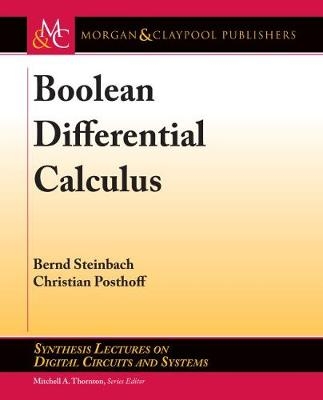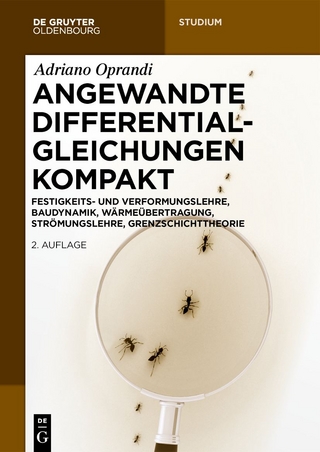
Boolean Differential Calculus
Morgan and Claypool Life Sciences (Verlag)
978-1-62705-922-0 (ISBN)
The Boolean Differential Calculus (BDC) is a very powerful theory that extends the basic concepts of Boolean Algebras significantly.
Its applications are based on Boolean spaces and Boolean operations, and basic structures such as Boolean Algebras and Boolean Rings, Boolean functions, Boolean equations, Boolean inequalities, incompletely specified Boolean functions, and Boolean lattices of Boolean functions. These basics, sometimes also called switching theory, are widely used in many modern information processing applications.
The BDC extends the known concepts and allows the consideration of changes of function values. Such changes can be explored for pairs of function values as well as for whole subspaces. The BDC defines a small number of derivative and differential operations. Many existing theorems are very welcome and allow new insights due to possible transformations of problems. The available operations of the BDC have been efficiently implemented in several software packages.
The common use of the basic concepts and the BDC opens a very wide field of applications. The roots of the BDC go back to the practical problem of testing digital circuits. The BDC deals with changes of signals which are very important in applications of the analysis and the synthesis of digital circuits. The comprehensive evaluation and utilization of properties of Boolean functions allow, for instance, to decompose Boolean functions very efficiently; this can be applied not only in circuit design, but also in data mining. Other examples for the use of the BDC are the detection of hazards or cryptography. The knowledge of the BDC gives the scientists and engineers an extended insight into Boolean problems leading to new applications, e.g., the use of Boolean lattices of Boolean functions.
From 1973-1977, Bernd Steinbach studied Information Technology at the University of Technology in Chemnitz (Germany) and graduated with an M.Sc. in 1977. He graduated with a Ph.D. and with a Dr. sc. techn. (Doctor scientiae technicarum) for his second doctoral thesis from the Faculty of Electrical Engineering of the Chemnitz University of Technology in 1981 and 1984, respectively. In 1991, Steinbach obtained the habilitation (Dr.-Ing. habil.) from the same faculty. Topics of his theses involved Boolean equations, Boolean differential equations, and their application in the field of circuit design using efficient algorithms and data structures on computers. Steinbach worked in industry as an electrician, where he had tested professional controlling systems at the Niles Company. After his studies he taught as Assistant Lecturer at the Department of Information Technology of the Chemnitz University of Technology. As a research engineer he developed programs for test pattern generation for computer circuits at the company Robotron. He later returned to the Department of Information Technology of the Chemnitz University of Technology as Associate Professor for design automation in logic design. Since 1992 he has worked as a Full Professor of Computer Science/Software Engineering and Programming at the Freiberg University of Mining and Technology, Department of Computer Science. He has served as Head of the Department of Computer Science and Vice-Dean of the Faculty of Mathematics and Computer Science. His research areas include logic functions and equations and their application in many fields, such as artificial intelligence, UML-based testing of software, and UML based hardware/software co-design. He is the head of a group that developed the XBOOLE software system. He published three books about logic synthesis. The first one (together with D. Bochmann) covers Logic Design using XBOOLE (in German), Technik 1991. The following two, co-authored by Christian Posthoff, are Logic Functions and Equations--Binary Models for Computer Science and Logic Functions and Equations--Examples and Exercises, Springer 2004, and 2009, respectively. As one application of the Boolean Differential Calculus, he co-authored another book with Christian Posthoff, Boolean Differential Equations, Morgan & Claypool Publishers 2013. He is the editor and co-author of several sections of the books Recent Problems in the Boolean Domain and Problems and New Solutions in the Boolean Domain, both of which were published by Cambridge Scholars Publishing in 2014 and 2016, respectively. Again co-authored by Christian Posthoff, he published three textbooks in German: Logic Functions Boolean Models, Efficient Calculations Using XBOOLE, and Java Programming for Beginners EAGLE 2014, 2015, and 2016. He published more than 250 chapters in books, complete issues of journals, and papers in journals and proceedings. He has served as Program Chairman for the IEEE International Symposium on Multiple-Valued Logic (ISMVL), and as guest editor of the Journal of Multiple-Valued Logic and Soft Computing. He is the initiator and general chair of a biennial series of International Workshops on Boolean Problems (IWSBP) which started in 1994, now with 12 workshops. He received the Barkhausen Award from the University of Technology Dresden in 1983. From 1963-1968, Christian Posthoff studied Mathematics at the University of Leipzig. His thesis was titled: Axiomatic Description of a Finite Class Calculus (Prof. Dr. Klaua). From 1968-1972, he worked as a programmer and in the field of Operations Research; simultaneously, he did his Ph.D. in 1975 with the thesis Application of Mathematical Methods in Communicative Psychotherapy. In 1972, he joined the Department of Information Technology at the Chemnitz University of Technology; until 1983, his research activities concentrated on logic design, particularly on numerical methods for Boolean problems. His cooperation with B. Steinbach goes back to these days. Important results have been algorithms and programs for solving Boolean equations with a high number of variables and the Boolean Differential Calculus for the analytical treatment of different problems in the field of logic design. These results have been collected in a monograph Binary Dynamic Systems published simultaneously in Akademie-Verlag Berlin, Oldenbourg-Verlag Munich-Vienna and in the Soviet Union, and allowed the habilitation (Dr.- Ing. habil.) at the Faculty of Electrical Engineering in 1979 and the promotion to Associate Professor. He wrote two textbooks at this time, aimed at a higher level in the theoretical and mathematical training of graduate engineers of information technology. About 1976, he started research activities in Artificial Intelligence. In 1983, Posthoff started as Full Professor of Computer Science in the Department of Computer Science at the same university, with the aim of starting the program in Computer Science in 1984. In 1984, he became Head of the Institute of Theoretical Computer Science and Artificial Intelligence and Research Director of the Department of Computer Science. An independent direction of research activities within AI, investigations of computer chess and other strategic games, arose from his love for chess. His research activities concentrated on the application of fuzzy logic for the modeling of human-like thinking methods, the learning from examples, the construction of intelligent tutoring systems, the application of inference mechanisms, the construction of systems for diagnosis, and configuration. In cooperation with colleagues from different areas of mechanical engineering and medicine, he has been supervising the construction of several expert systems. He received the Scientific Award of the Chemnitz University of Technology four times. In 1994, he moved to the Chair of Computer Science at the University of The West Indies, St. Augustine, Trinidad & Tobago. From 1996-2002 he was Head of the Department of Mathematics & Computer Science. His main focus was the development of Computer Science education at the undergraduate and graduate level to attain international standard. In 2001, he received the Vice-Chancellor's Award of Excellence. He is the author or co-author of 19 books and many publications in journals and conference proceedings. Mitchell A. (Mitch) Thornton received the BS degree in electrical engineering from Oklahoma State University in Stillwater, OK, in 1985, the MS degree in electrical engineering from the University of Texas-Arlington in Arlington, Texas, in 1990, the MS degree in computer science from Southern Methodist University in 1993, and the PhD degree in computer engineering from Southern Methodist University in 1995. He was a senior electronic systems engineer at E-Systems, Inc. in Greenville, TX from 1986 through 1991. He was employed as a design engineer at Cyrix Corporation from 1992 through 1993. He has served as a full-time faculty member in the University of Arkansas from 1995 to 1999, and Mississippi State University from 1999 to 2002. Currently he is the Cecil H. Green Chair of Engineering and Professor at Southern Methodist University in the Computer Science and Engineering Department, and by courtesy, in the Electrical Engineering Department. He also serves as the Technical Director of the Darwin Deason Institute for Cyber Security. Dr. Thornton has research and teaching interests in the general area of digital circuits and systems design with specific emphasis in EDA/CAD methods including asynchronous circuit and computer arithmetic circuit synthesis, formal verification/validation and simulation of digital systems, multiple-valued logic, and spectral techniques. Dr. Thornton also works in the area of emerging technology in clouding reversible and quantum logic and computing. Dr. Thornton is an active industrial consultant and is a licensed professional engineer in the States of Arkansas, Mississippi, and Texas. He has served numerous roles in professional societies such as IEEE, NSPE, and NCEES as well as an organizing committee member for symposia and conferences.
Introduction
Basics of Boolean Structures
Derivative Operations of Boolean Functions
Derivative Operations of Lattices of Boolean Functions
Differentials and Differential Operations
Applications
Solutions of the Exercises
Bibliography
Authors' Biographies
Index
| Erscheinungsdatum | 28.06.2017 |
|---|---|
| Reihe/Serie | Synthesis Lectures on Digital Circuits and Systems |
| Mitarbeit |
Herausgeber (Serie): Mitchell A. Thornton |
| Verlagsort | San Rafael, CA |
| Sprache | englisch |
| Maße | 191 x 235 mm |
| Gewicht | 415 g |
| Themenwelt | Mathematik / Informatik ► Mathematik ► Analysis |
| Technik ► Elektrotechnik / Energietechnik | |
| ISBN-10 | 1-62705-922-9 / 1627059229 |
| ISBN-13 | 978-1-62705-922-0 / 9781627059220 |
| Zustand | Neuware |
| Informationen gemäß Produktsicherheitsverordnung (GPSR) | |
| Haben Sie eine Frage zum Produkt? |
aus dem Bereich


